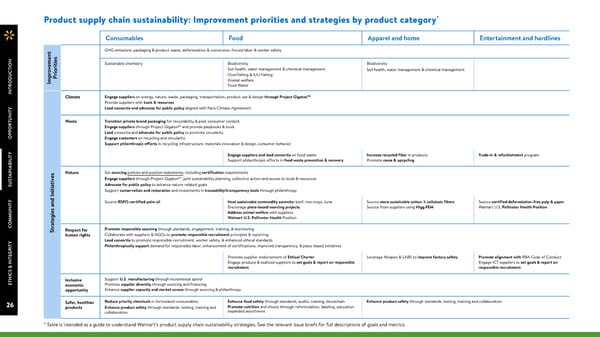* Product supply chain sustainability: Improvement priorities and strategies by product category Consumables Food Apparel and home Entertainment and hardlines t GHG emissions, packaging & product waste, deforestation & conversion, forced labor & worker safety en s N e Sustainable chemistry Biodiversity Biodiversity O ti em i TI v r Soil health, water management & chemical management Soil health, water management & chemical management C o io U r r Overfishing & IUU fishing D p P O m Animal welfare I Food Waste NTR I TM Climate Engage suppliers on energy, nature, waste, packaging, transportation, product use & design through Project Gigaton Provide suppliers with tools & resources Y Lead consortia and advocate for public policy aligned with Paris Climate Agreement T I N TU Waste Transition private brand packaging for recyclability & post-consumer content R TM and provide playbooks & tools O Engage suppliers through Project Gigaton P Lead consortia and advocate for public policy to promote circularity P O Engage customers on recycling and circularity Support philanthropic efforts in recycling infrastructure, materials innovation & design, consumer behavior Y Engage suppliers and lead consortia on food waste Increase recycled fiber in products Trade-in & refurbishment program T I Support philanthropic efforts in food waste prevention & recovery Promote reuse & upcycling IL B A IN s Nature Set sourcing policies and position statements, including certification requirements A e TM ST v Engage suppliers through Project Gigaton , joint sustainability planning, collective action and access to tools & resources i U t Advocate for public policy to advance nature-related goals S a i t Support conservation and restoration and investments in traceability/transparency tools through philanthropy Ini Y d Source RSPO-certified palm oil Host sustainable commodity summits: beef, row crops, tuna Source more sustainable cotton & cellulosic fibers Source certified deforestation-free pulp & paper IT an Encourage place-based sourcing projects Source from suppliers using Higg FEM Walmart U.S. Pollinator Health Position N s U e Address animal welfare with suppliers M gi Walmart U.S. Pollinator Health Position e OM t a C r t Respect for Promote responsible sourcing through standards, engagement, training, & monitoring S Collaborate with suppliers & NGOs to promote responsible recruitment principles & reporting human rights Y Lead consortia to promote responsible recruitment, worker safety, & enhanced ethical standards T Philanthropically support demand for responsible labor, enhancement of certifications, improved transparency, & place-based initiatives I R G E Promote supplier endorsement of Ethical Charter Leverage Nirapon & LABS to improve factory safety Promote alignment with RBA Code of Conduct NT Engage produce & seafood suppliers to set goals & report on responsible Engage ICT suppliers to set goals & report on I & recruitment responsible recruitment S C I TH Inclusive Support U.S. manufacturing through incremental spend E economic Promote supplier diversity through sourcing and financing opportunity Enhance supplier capacity and market access through sourcing & philanthropy 26 Safer, healthier Reduce priority chemicals in formulated consumables Enhance food safety through standards, audits, training, blockchain Enhance product safety through standards, testing, training and collaboration products Enhance product safety through standards, testing, training and Promote nutrition and choice through reformulation, labeling, education, collaboration expanded assortment * Table is intended as a guide to understand Walmart’s product supply chain sustainability strategies. See the relevant issue briefs for full descriptions of goals and metrics.
 ESG Report | Walmart Page 25 Page 27
ESG Report | Walmart Page 25 Page 27